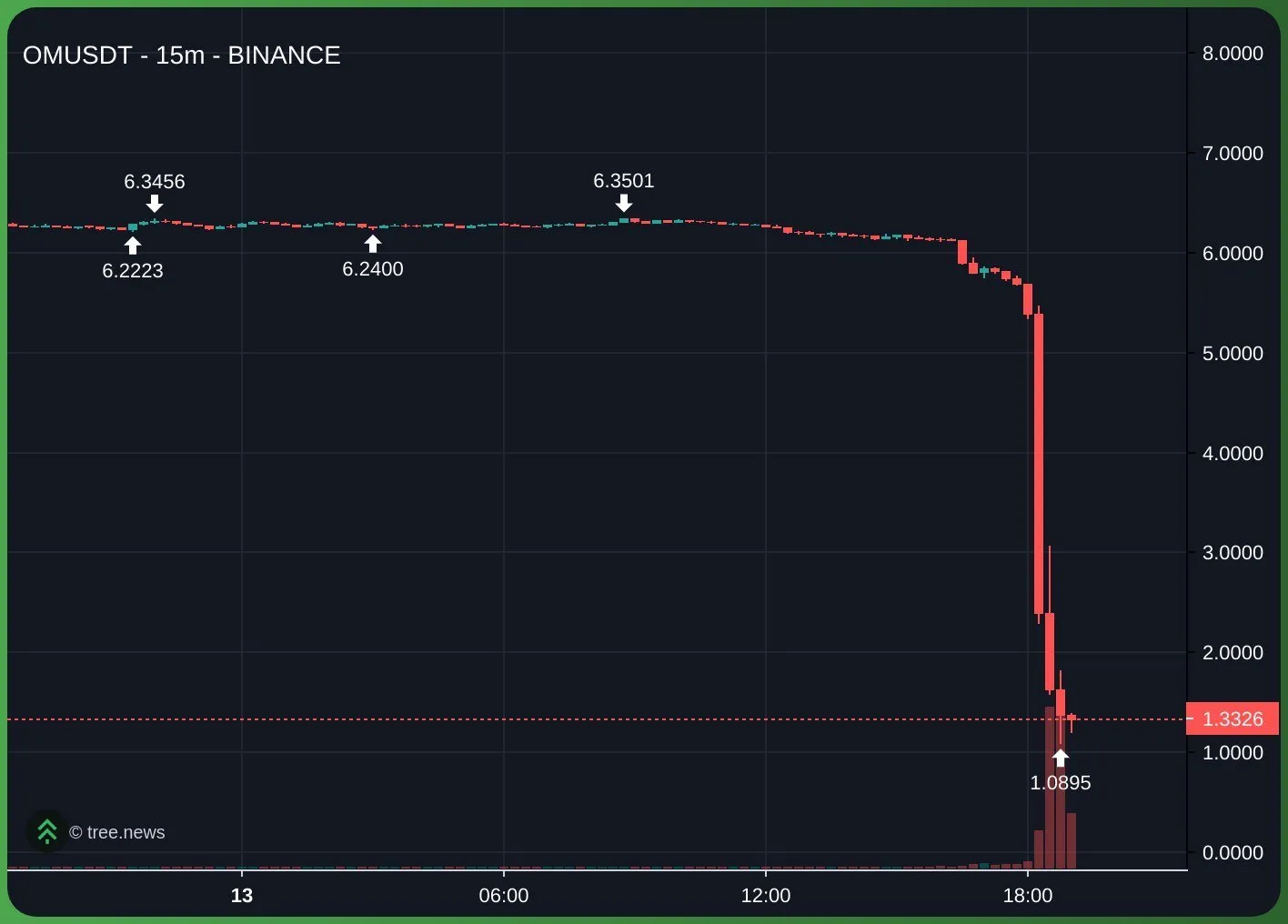The $OM Token Crash: A Shocking 90% Drop
On April 13, 2025, the crypto world was rocked by a jaw-dropping event: the MANTRA ($OM) token plummeted by 90% in a single 15-minute candle, wiping out approximately $3.5 billion in market cap. A viral X post by @AlwaysBeenChoze shared a chart showing the price nosedive on Binance, dropping from around 6,400 to 1,358. The post accused the MANTRA team of dumping 90% of the circulating supply and deleting their official Telegram group, likening the event to the infamous Terra Luna collapse of 2022, where a stablecoin failure led to billions in losses.
Allegations of a Team Dump and Community Backlash
The X post by @AlwaysBeenChoze didn’t hold back, directly pointing fingers at MANTRA’s co-founder, JP Mullin (@jp_mullin888), claiming the team orchestrated a massive rug pull—a term used in crypto to describe when a project team abandons the project and sells off their tokens, leaving investors high and dry. The post also alleged that MANTRA deleted their official Telegram group, cutting off communication with their community during the crisis. This sparked a firestorm of reactions on X, with users like @AllGreenCandles asking if this was “the largest actual real rug pull of all time,” while others, like @Jeetburner, expressed frustration over losing millions, accusing the team of orchestrating a “well-orchestrated liquidity exit.”
However, not everyone agreed with the rug pull narrative. Some community members pushed back against the claims. For instance, @tomuky called out the misinformation about the Telegram group deletion, and @delomiro provided a link to the still-active MANTRA Telegram group, proving it wasn’t deleted. This raised questions about the accuracy of the initial allegations and whether the crash was truly the result of a team dump.
MANTRA’s Response: Forced Liquidations, Not a Team Dump
JP Mullin quickly responded to the allegations, clarifying that the crash wasn’t caused by the MANTRA team or its investors selling tokens. In a detailed X post, Mullin explained that the $OM market movements were triggered by “reckless forced closures” initiated by centralized exchanges (CEXs) on OM account holders. He noted that the timing—during low-liquidity hours on a Sunday evening UTC (early morning Asia time)—suggested either negligence or intentional market positioning by these exchanges. Mullin emphasized that the team’s tokens remained locked and verifiable on the blockchain at the address mantra1yejpacug78zuqkzwwuc94c0a2al4mz4yfqquam, and MANTRA was committed to transparency.
Mullin’s statement was backed by a report from Crypto Briefing, where he further elaborated that the “sudden closure of account positions” by CEXs, without sufficient warning, caused the crash. While he didn’t name specific exchanges, he criticized their unchecked discretionary powers, which led to the market dislocation. MANTRA also announced plans for a community connect session on X to discuss the event further, urging users to avoid scam links and rely only on official communications from Mullin’s account or the main MANTRA X account.
The Bigger Picture: Forced Liquidations and Market Dynamics
The $OM crash sheds light on a broader issue in the crypto space: the risks of centralized exchanges and forced liquidations. A forced liquidation happens when an exchange automatically closes a trader’s leveraged position due to insufficient collateral, often during volatile market conditions. In $OM’s case, the low-liquidity window on a Sunday evening exacerbated the impact, causing a cascading effect as positions were liquidated en masse, driving the price down further.
This isn’t the first time CEXs have been implicated in such events. A Crypto Briefing report noted that several altcoins, including Act I: The AI Prophecy and DeXe, faced sharp declines on Binance after the exchange revised margin requirements, increasing liquidation risks for undercollateralized positions. MANTRA’s situation seems to follow a similar pattern, highlighting the need for better oversight and risk management in the crypto trading ecosystem.
Community Sentiment and Lessons Learned
The $OM crash left the crypto community divided. Some investors, like @bon_g, expressed deep despair, with one claiming to have lost $15 million and calling the industry a scam. Others, like @seleris77, shared their experiences with past crypto crashes like Terra Luna, advising newcomers to allocate 70-80% of their portfolio to Bitcoin and treat altcoins as experimental investments. The incident also sparked broader concerns about the real-world asset (RWA) narrative—a sector MANTRA was heavily involved in—potentially leading to a decline in trust for RWA-focused projects and altcoins in general.
On the other hand, MANTRA’s proactive response and transparency about their tokenomics helped mitigate some of the damage. The project, which operates as a Layer 1 blockchain built on the Cosmos SDK for tokenizing real-world assets, has a history of resilience, surviving multiple market cycles. As Mullin noted, MANTRA has continued building even when others stopped, with recent milestones like being the first DeFi protocol licensed by Dubai’s VARA and integrating initiatives to strengthen its ecosystem.
What’s Next for MANTRA and $OM Investors?
The $OM token crash is a stark reminder of the volatility and risks in the crypto market, especially when centralized entities hold significant control over liquidity and trading. For MANTRA, the road ahead involves rebuilding trust with its community, which Mullin has already started by addressing the issue head-on and promising further updates. Investors, meanwhile, are left to reassess their strategies, with some like @h4n5um ironically noting that if the team did sell, it might mean “up only” from here—a tongue-in-cheek take on the situation.
For those affected by the crash, documenting holdings and transactions is crucial, as advised by CryptoTicker, especially if legal action becomes a possibility, as hinted by @Jeetburner’s mention of involving crypto legal representatives. As the crypto space continues to evolve, incidents like these underscore the importance of due diligence, risk management, and the need for more decentralized and transparent systems to protect investors.
If you’re following the $OM saga, stay tuned for MANTRA’s upcoming community connect on X, and be cautious of scam links posing as official communications. What are your thoughts on the crash—do you think it was a CEX failure, or is there more to the story? Let us know in the comments!


